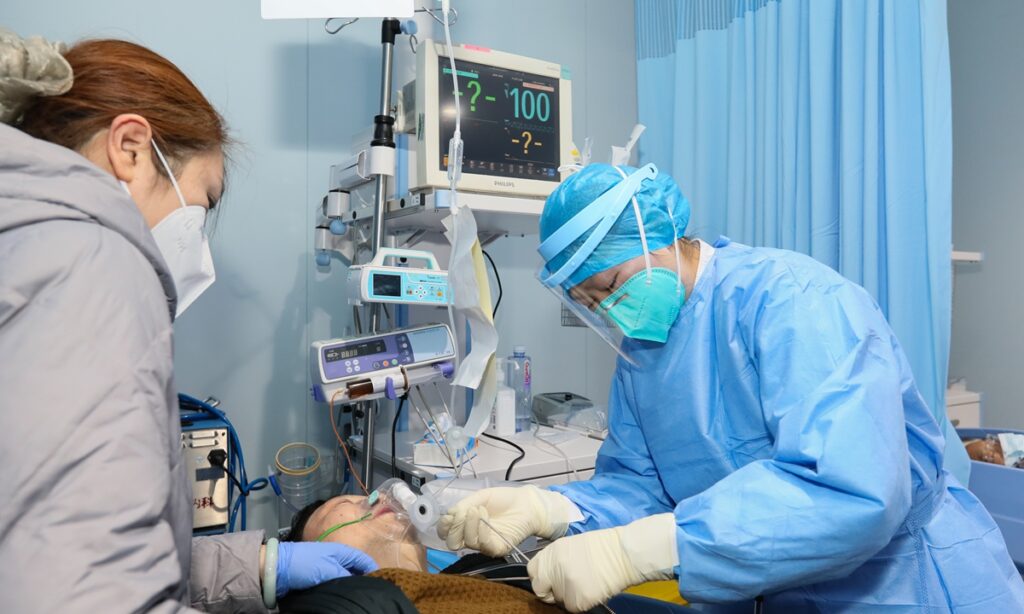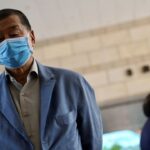Doctors more confident in combating epidemic with experience gained over 3 years
Officials from the National Health Commission (NHC) said that the government has anticipated increased demand for medical treatment while optimizing epidemic prevention measures, and is trying to delay peak infections as much as possible by increasing the number of fever clinics and medicines.
The remarks were made as second and third tier cities and county-level regions in China are going all-out with the successful experience they gained over the past three years to fight surging cases, as Omicron strikes these places earlier than expected, resulting in a severe shortage of personnel and medical resources.
The NHC has required all hospitals to open fever clinics to meet the medical needs of fever patients as much as possible. As of December 25, 2022, there were more than 16,000 fever clinics in hospitals at or above the second level across the country, and more than 41,000 fever clinics and fever consulting rooms in community-level medical institutions, Jiao Yahui, director of the Medical Administration Bureau of the NHC, said to China Central Television News on Sunday.
In addition, gymnasiums, nucleic acid testing sites and makeshift hospitals also provide support for triage patients to relieve pressure on hospitals, where people can access medical consultations and medication.
According to media reports, on November 25, 2022, Peking Union Medical College Hospital launched a project to build a makeshift fever clinic, which was completed and put into use two days later. On December 9, 2022, the hospital kicked off an emergency fever clinic reconstruction project, which was officially put into operation 10 days later.
In the China-Japan Friendship Hospital in Beijing, a group of retired doctors and nurses returned to work to fight on the front line of epidemic prevention and control. According to incomplete statistics from the hospital, there are currently more than 80 retired and re-employed physicians who insisted on carrying out surgeries, and more than 50 retired nurses are on the front line of anti-epidemic prevention.
Hospitals across China have been waging a war against COVID-19 since infections started to rocket after the country adjusted its epidemic policies in early December. As the situation progressed, the pressure to treat patients in hospitals began to spread from fever clinics to emergency and intensive care units (ICU), with the number of patients treated in ICU at many hospitals nearly tripling over previous levels.
The Global Times learned from the Tongji Hospital affiliated with the Tongji Medical College of the Huazhong University of Science and Technology that the number of emergency and fever outpatients in the hospital increased sharply in the past week.
Currently, the emergency department and fever clinic of the third district of Tongji Hospital receive an average of 2,200 patients per day, and rescue 210 people per day, and ICU beds in the hospital continue to operate at full capacity. On December 30, 92.32 percent of COVID-19 patients in the Tongji Hospital were in severe or critical condition, making the hospital the medical institution with the largest number of patients with severe and critical symptoms in Wuhan, Central China’s Hubei Province, the first place in the world to have been hit by COVID-19.
A similar situation can be seen in the Jiangsu Province Hospital. Admissions to its emergency department nearly tripled from 500 to 1,200 recently.
“We have made preparations, but the first infection wave came earlier and more violently than expected,” Chen Xufeng, dean of the emergency medical center of the Jiangsu Province Hospital, told the Global Times.
The most difficult part is seeing medical colleagues continually being infected by the virus while patients kept pouring in, Chen said. “It makes me feel so anxious and powerless to see the number of comrades around me shrinking.”
But compared with the situation three years ago, when the country was suddenly hit by a totally unknown disease, Chinese medical staff say they have more confidence and experience this time to overcome the epidemic.
In order to expand its ability to treat severe cases, the Tongji Hospital has broken the traditional model of specialized treatment for specialized diseases and is now accepting COVID-19 patients in all of its departments. As a result, ICU beds have nearly doubled in the hospital from 564 to 1,042, of which more than 60 percent are for respiratory patients.
After receiving a patient, doctors will conduct a quick check and triage. Patients who are critically ill and whose vital signs are unstable will be sent to the emergency room immediately. Ordinary and mild patients will be observed and treated in designated areas. Patients who need to be hospitalized will be identified and classified as emergency cases – for example, critically ill patients with serious underlying diseases will be marked in red, and reported to the hospital’s epidemic management team in real time, the Global Times learned.
“This time, we have basically figured out the nature of the disease, knowing where to go and where to put our energy for critical illness treatment,” Zhou Ning, a doctor from the Tongji Hospital, told the Global Times, adding that there is no sense of panic and helplessness like there was three years ago.
Compared with the Wuhan epidemic in 2020, this round of the epidemic has caused a large number of infections and downsizing of medical staff, and there is no support from medical staff from other provinces. But the advantage is that most of the critical illnesses from this round of infected patients are progressing more slowly and many of them mainly show respiratory diseases. In addition, the treatment plan is easy to standardize, Fang Minghao, a doctor from Tongji Hospital, told the Global Times.
“Accurate judgment in moving the treatment threshold forward and prone position ventilation is an important weapon that has been used by our emergency department in the past three years,” Li Shusheng, director of the emergency center of the Tongji Hospital, told the Global Times, adding that with more colleagues recovering from infection, “we are confident in protecting the lives and health of patients in the emergency department.”
“Now we also have more treatment options against the disease,” Ran Xiao, another doctor from Tongji who was part of the 2020 fight against the epidemic, told the Global Times.
The first and second weeks after the peak of infections tend to be the hardest period for the medical staff, according to Jiao. She noted that the virus must go through its coefficient of transmission, which will become weaker after a certain point in time. The epidemic situation will gradually be brought under control as long as the country gets past the peak of the infection.
“We all have the best vision and the strongest belief, and we will persevere and persist. The first week may be difficult, but we believe that the first ray of sunshine in spring is already on the way,” Cao Quan, a doctor from the ICU of the Jiangsu Province Hospital, told the
(Global Times)




